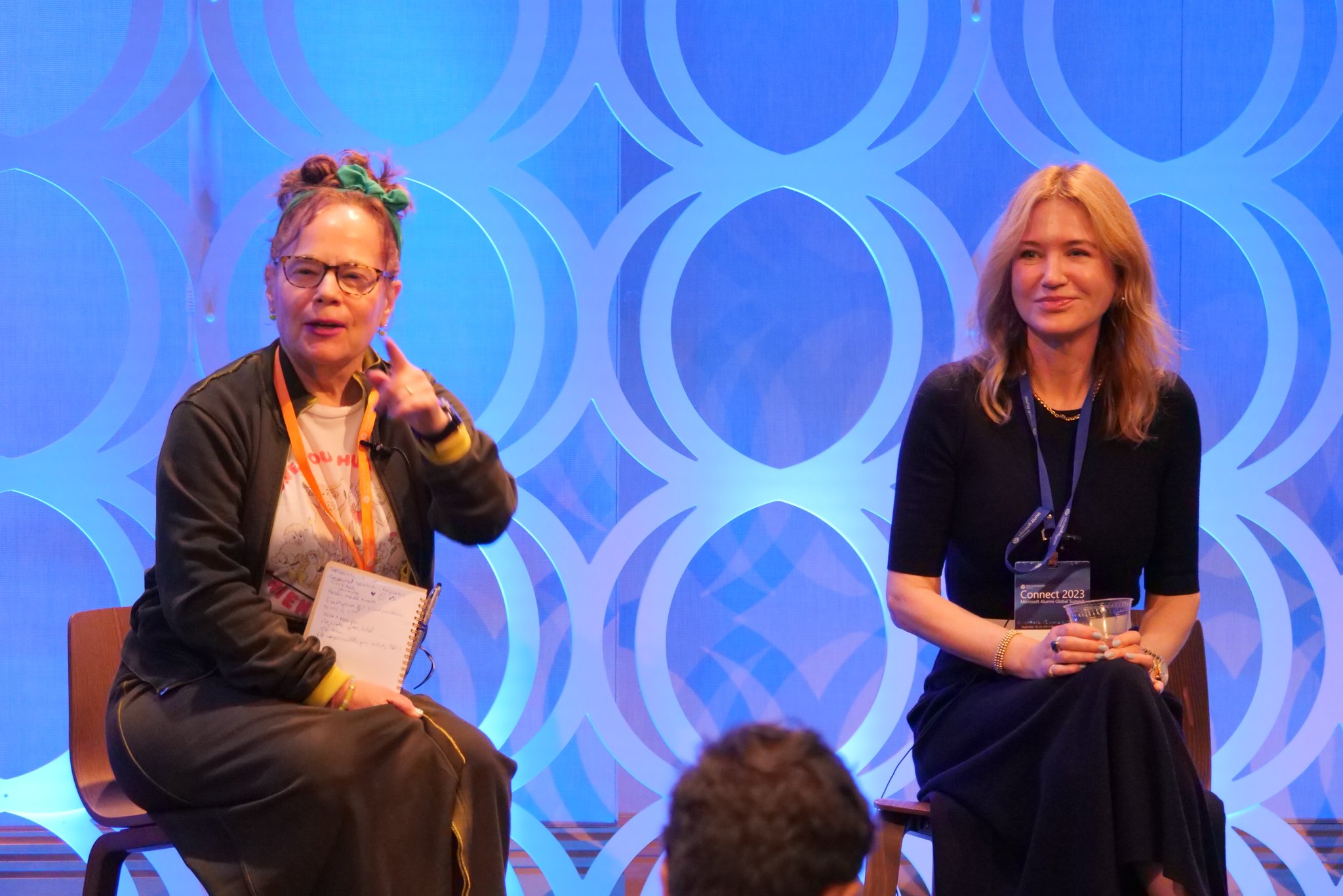
REDMOND, Wash. — Mike Sievert knew exactly how to break the ice with this crowd.
“It’s really great for me to be able to finally come and collect your thanks and adulation for Windows Vista,” the T-Mobile CEO and former Windows marketing executive said with a grin, getting a big laugh about one of the company’s legendary duds from hundreds of former Microsoft employees and executives Thursday.
The scene inside the Microsoft conference center felt like a reunion, as more than 600 people from 17 countries gathered for the Microsoft Alumni Network‘s Connect 2023 global conference, which wraps up Friday morning. Microsoft will turn 50 in less than two years, and attendees spanned many of the company’s decades.

Attendees picked up complimentary shirts bearing the company’s original logo, made strategic business connections in the “Deal Room,” and caught up cheerfully with former colleagues in the hallways of Building 33.
While the mood was light, the subjects were serious, with sessions designed to help alumni navigate the worlds of entrepreneurship, philanthropy, and the coming wave of artificial intelligence in their work and personal lives.
An important piece of business at the event was the introduction of a new executive director for the 48,000-person Microsoft Alumni Network, Manuela Papadopol, who succeeds Ali Spain after her seven years in the role.
Microsoft President Brad Smith, in a recorded video address at the outset of the conference, described the rise of AI as a moment equal or greater to the platforms and technologies that many people in the room pioneered — including the personal computer, the graphical user interface, the internet, and mobile computing.
“Here we are, again, at an extraordinarily important inflection point for Microsoft, for the world, for the tech sector, and most importantly for everybody who uses our products,” Smith said, adding that he believes the company is in “an extraordinarily good position to not just ride but lead so much of this next wave of innovation.”

The serious nature of the crowd was underscored during a Q&A session with Charlie Bell, the Microsoft executive vice president in charge of security technologies, who joined the company after a long tenure with Amazon Web Services. Some of the Microsoft alumni in the crowd pressed Bell to explain and defend his optimism about general artificial intelligence and what one described as “asymmetric warfare” with online attackers.
Speaking from the stage, Bell disagreed with the premise of that question, saying he believes the security principle of defense in depth will ultimately prevail.
“I don’t buy the idea that [attackers] just have to be right once,” he said. “I think we’re making it so they have to be right a lot.”
He predicted it will get “to the point where they have to be right so many times in series, they’re just never going to get there. Probabilistically, it’s too hard.”

“Datapreneurs” author Bob Muglia, the former Snowflake CEO who ran the Server & Tools division and other businesses during a long Microsoft tenure, put the current state of AI in the context of Gartner’s famed “hype cycle” for emerging technologies. He said AI is about to enter the dreaded “trough of disillusionment,” and may be in it now.
“The hype has been the fastest I can remember,” he said. “But I think the trough will be one of the shortest I’ve ever seen.” A key barometer to watch, he said, will be the adoption of Microsoft 365 Copilot starting in early November.

Another session focused on the metaverse, with Magic Leap CTO Julie Larson-Green, a former Microsoft Windows and Office engineering executive.
Asked about the near-term possibilities for monetizing augmented reality in business and enterprise markets, Larson-Green cited training and 3D collaboration, with healthcare further out.
Artificial intelligence will play a major role in the evolution of augmented reality, Larson-Green said. “It’s an AI device,” she said. “Augmented reality is the medium, but it is really an AI processing device.”

Four Microsoft alumni who are part of different sports ownership groups shared insights on the similarities and differences between professional sports and the technology business: Terry Myerson (Seattle Sounders FC), Dawn Trudeau (Seattle Storm), Rahul Sood (Jaffna Stallions), and Jeff Raikes (Seattle Mariners).
Some of the panelists said they appreciated the “local” nature of the sports teams, and the ability to impact the immediate community around them, compared to the global nature of their work at Microsoft.
“When I think about the Windows 10 launch, and the media statistics we talked about …. this is not that,” said Myerson, the former Windows chief, who now leads health data company Truveta. More important for the Sounders, he said, is how many kids are wearing jerseys to school on game days, for example.
Toward the end of Sievert’s session, which was moderated by Trudeau, an attendee gave him kudos for referencing the poorly received Windows Vista operating system, and asked him what lessons he drew from the experience that he has carried forward into his post-Microsoft leadership roles.
“I’m not overly critical of the company and our processes back then, but I think Windows Vista just wasn’t ready, and it wasn’t deeply connected with what customers wanted,” Sievert said, referring to the importance of maintaining a tight connection between marketing, product management, and engineering.
Eventually, he said, Microsoft got there. “I wanted to name Windows 7, Windows Vista Good Edition,” Sievert joked. “I thought that was a better name.”



